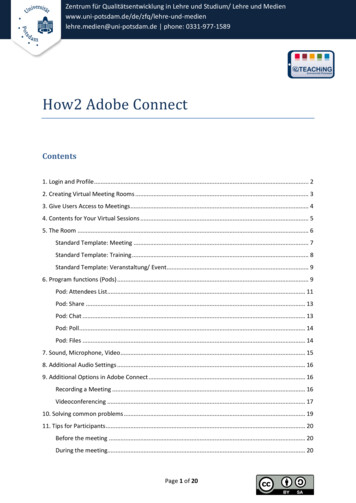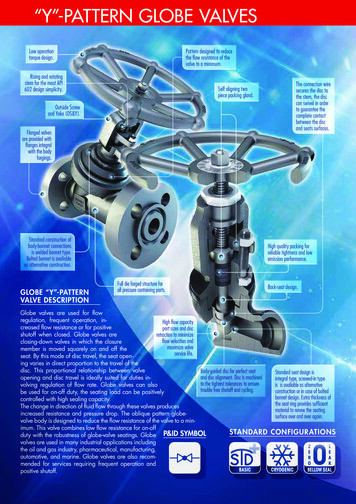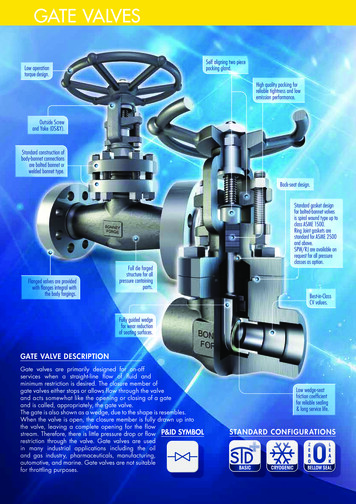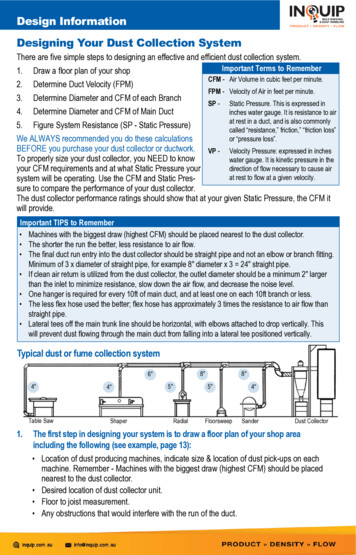
Transcription
HOW2Determine BFE Outside a FloodplainBase Flood Elevations from One-Dimensional (1D) AnalysisAs a participating community in the National Flood Insurance Program, the minimum standards outlined inthe Code of Federal regulation require communities to (1) permit all development, (2) review all proposeddevelopment, and (3) assure that development activities will be built in a manner that will be reasonably safefrom flooding. Developments in excess of 5 lots or 50 acres are required to determine a Base FloodElevation (BFE) - 44CFR60.3(b)(3). This document will help you to determine a BFE for sites that are outsideof a designated floodplain extent using Base Level Engineering (BLE) data and the BFE Interpolate Tool.Permitting should require new construction in the vicinity of flood prone areas to buildat or above the Base Flood Elevation (BFE). FIRMs may be complemented by thedata on the Estimated BFE viewer, providing additional flood information to supportlocal permitting efforts. Communities may permit at or above the base floodelevation. To further reduce flood potential of new structures communities mayadopt/enforce a freeboard (1 or 2 feet) that is added to the Base Flood Elevation.12Locate your project area on the current effective FIRMs. Effective, historic, preliminary andpending FIRMs may be accessed on FEMA’s Map Service Center website at https://msc.fema.govor the National Flood Hazard Layer viewer at https://msc.fema.gov/nfhl.Find Base Level Engineering data. Once you have accessed the site, review the DISCLAIMER,click OK. You will be greeted with a screen, select View Base Level Engineering Data from thethree available options. On the left of the screen, click the REPORT tab enter the location, oraddress of interest. Locate your project area and print the property flood report, if available.The graphic to the leftillustrates two scenarios.AA – When a structure iswithin the floodplain shownon the estBFE viewer, thereport function can be usedto estimate the BFE.BB – When the structure isin the vicinity of thefloodplain, but outside ofthe floodplain delineatedthe BLE data can be usedto estimate the BFE.If your project is near a floodplain (Zone A/X on FIRMs) or mapped on viewer but not on FIRMs,you can leverage the BLE datasets to establish a Base Flood Elevation (BFE), see stepsbeginning on the next page. If there is no data in the S XS file, then skip to the 2D step-by-stepinstructions starting on page 4.
3Download BLE Data. Using the download layer (turn on with the Data Layers button – at top left),click on the teal watershed in the vicinity of your interest area. Download the following three itemsfrom the viewer – 1% event depths, 1% event elevations, and Vector Spatial Data. In order toaccess this information, you will need to utilize GIS software. Free software is available fordownload, allowing interaction with the BLE data, a couple include: ArcReader can be freely downloaded at: er QGIS is freely available for download at: l4Open/Add the following BLE database layers/coverage to your GIS software – 1% event depths(BLE DEP01PCT), 1% event elevations file (BLE WSE01PCT), FLD HAZ AR (floodplains),S WTR LN (stream centerlines), and S XS (modeling cross-sections). When these files areadded to GIS software, the picture you will seewill appear something like the one below.Red box in the graphic to the right indicates thestructure to be analyzed. This structure will beused for our example, we will estimate a baseflood elevation for this location. Black Linesshow location of analysis cross-sections. Crosssections are labeled with analysis Stream STN.This field is available in the database. Blue lineis the stream centerline. Pink shades the area where flood waters are expected during the 1%annual chance event, called the “floodplain”. This floodplain is overlaying a blue gridded floodarea depicting the flood depths for a larger extent, the 0.2% annual chance event.5Zoom into the structure of concern and locate/identify the analysis cross-sections in your areaof concern. In the image to the right we havehighlighted the two cross-sections (orange)available in the vicinity of the structure ofinterest. Find the identification tool in your GISsoftware and investigate the informationavailable within the S XS file.Click on each cross-section and write down thenumeric values in the following data fields –Stream STN and E WSE 1PCT. The first valueis the stream station, this is an indication of the spacing of each cross-section.The second value is the estimated Base Flood Elevation during the 1% annualchance storm event. If you review the Stream STN value the larger valuedenotes the upstream XS (XS1 in this case), the other is the downstream cross-section.6Draw a cross-section (green) to intersect themost upstream corner of the structure inquestion and extend it to stream centerline.Using the measure tool in your GIS toolmeasure from US cross-section to the crosssection you created. Mark down themeasurement, 224.019 in this example.224.019 feet
7Download the BFE Interpolate Tool from FEMA’s website at the following web location:https://go.usa.gov/xsGGx. This excel file will assist in calculating an estimated BFE based onthe values you have collected, the values for the example are included below.XS 1 (Upstream)Stream STN 16325.416 (A)XS2 (Downstream)Stream STN 15653.342 (C)Measure (US to Drawn XS) 224.019 (E)E WSE 1PCT 102.9 (B)E WSE 1PCT 101.6 (D)The greyed-out cells are calculation cells in the tool (column E) and should not be altered.ABECDEstimated BFE for structure iscalculated (NAVD88) by toolOnce the five values are added to the interpolation tool, an estimated BFE is calculated by thetool. This value may be used for local permitting or may be used in the submittal of a Letter ofMap Amendment (LOMA). If a LOMA will besubmitted, include the following details in theElevation Certificate (Section B): B9 – Add BFE value determined. PrintBFE Interpolate tool page and include. B10 – Mark Other Source, indicate BaseLevel Engineering model (Stream name),download and include BLE model. B11 – check box for NAVD 1988Letter of Map Revision Based on Fill (LOMR- F). If fill will be placed, you can use theBLE modeling or request that a developer prepares analysis (existing conditions andproposed conditions) to determine the effect of fill along the water course. This willassure your community remains in alignment with the minimum NFIP requirements.
HOW2Determine BFE Outside a FloodplainBase Flood Elevations from Two-Dimensional (2D) AnalysisSome BLE watersheds are prepared with two-dimensional (2D) modeling where a gridded representation ofthe ground elevations is the basis of analysis versus cross-sections which are used in 1D modeling.3Download BLE Data. Using the download layer (turn onwith the Data Layers button – at top left), click on the tealwatershed in the vicinity of your interest area. Downloadthe following three items from the viewer – 1% eventdepths, 1% event elevations, and Vector Spatial Data. Inorder to access this information, you will need to utilizeGIS software. Free software is available for download,allowing interaction with the BLE data, a couple include:ArcReader can be freely downloaded eaderQGIS is freely available for download html4Open/Add the following BLE database layers/coverage toyour GIS software – 1% event depths, 1% eventelevations, and FLD HAZ AR (floodplains), S WTR LN(stream centerlines) and BFE 2D (elevation contours).When these files are added to GIS software the pictureyou will see will appear similar to the image below.1D analysis models several cross-sectionsalong a stream reach, these cross-sectionsare analyzed to determine a water surfaceelevation.2D analysis models use a gridded surfaceand a series of breaklines to define theanalysis areas.Green polygon in the graphic above indicates thestructure to be analyzed. This structure will be used forour example, we will estimate a base flood elevation forthis location. Grey dashed lines depict the BFE 2D, showing elevations of the water surface. Blue linedenotes the stream centerline. Pink shades the area where flood waters are expected during the 1%annual chance event, called the “floodplain”. This floodplain is overlaying a blue gridded flood areadepicting the flood depths for a larger extent, the 0.2% annual chance event.
56Zoom to the structure of concern and draw areference line (yellow in image to the right). Thisline should be drawn perpendicular to thefloodplain and drawn to align with the upstreammost point of the structure of concern. This line willprovide you a reference point to query the WaterSurface Elevation Grid and estimate a BFEelevation from the 1% event elevations file(BLE WSE01PCT).Select five or more locations along the line you have drawn and use a GIS identify tool to query the1% event elevation file to find a water surface elevation. Write down the pixel value returned whenyou click on each of the 5points along the line.Calculate the average ofthese five points to derive anestimated Base FloodElevation for the structure inquestion.In our example thiscalculation is detailed below(52.5 52.6 52.6 52.6 52.8)/5BFE 52.62 ftOnce the five values are added to the interpolation tool, an estimated BFE is calculated by thetool. This value may be used for local permitting or may be used in the submittal of a Letter ofMap Amendment (LOMA). If a LOMA will besubmitted, include the following details in theElevation Certificate (Section B): B9 – Add BFE value determined. Print ascreen shot and include a marked-upimage like that shown above. B10 – Mark Other Source, indicate BaseLevel Engineering model. You canindicate the name of the watershed andreference the estBFE viewer for the modelsource.Estimated BFE viewer address is:https://webapps.usgs.gov/infrm/estBFE/2D BLE modeling available for download –Little Red (08040301) – Models B11 – check box for NAVD 1988
Download BLE Data. Using the download layer (turn on with the Data Layers button - at top left), click on the teal watershed in the vicinity of your interest area. Download the following three items from the viewer - 1% event depths, 1% event elevations, and Vector Spatial Data. In order to access this information, you will need to utilize










